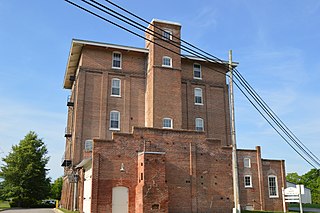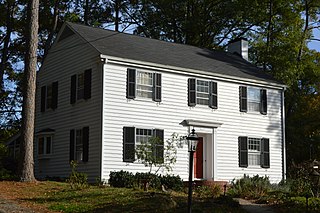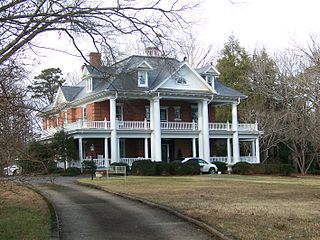
The Capitol Area Historic District is a national historic district located at Raleigh, North Carolina. The district encompasses 25 contributing buildings and was developed after 1792. The district includes notable examples of Classical Revival and Late Gothic Revival style architecture. Located in the district are the following separately listed buildings:
Alston-DeGraffenried Plantation or Alston-DeGraffenried House is a historic property located in Chatham County, North Carolina, near Pittsboro, North Carolina. It includes a plantation house built through the forced labor of at least 11 enslaved people between about 1810 and 1825, and its surrounding agricultural fields. The property was first listed on the National Register of Historic Places in 1974 and the listed area was increased in 1993. The house and the surrounding land are identified as a national historic district.

Halifax Historic District is a national historic district located at Halifax, Halifax County, North Carolina, US that was listed on the National Register of Historic Places in 1970. It includes several buildings that are individually listed on the National Register. Halifax was the site of the signing of the Halifax Resolves on April 12, 1776, a set of resolutions of the North Carolina Provincial Congress which led to the United States Declaration of Independence gaining the support of North Carolina's delegates to the Second Continental Congress in that year.

Kenworth Historic District is a national historic district located at Hickory, Catawba County, North Carolina. The district encompasses 52 contributing buildings and 2 contributing structures in the planned subdivision of Kenworth in Hickory. Most of the buildings date between the early- and mid-20th century and include notable examples of Colonial Revival and Bungalow / American Craftsman style architecture. Notable buildings include the (former) Christ Lutheran Church (1926), Kenworth Elementary School (1913), Frederick O. Bock House (1923), Nichelson-Abernethy House (1922), Speas-Duval House (1921), Clyde L. Herman House, Kennedy-Setzer House (1921), and Payne-Bothwell-Scheller House (1921).

Edenton Cotton Mill Historic District is a national historic district located at Edenton, Chowan County, North Carolina. The district encompasses 70 contributing buildings, 1 contributing site, 2 contributing structures, and 1 contributing object in a small mill village. It includes industrial and residential buildings developed between 1899 and 1923. Residential buildings are primarily simple one-story, single-pile, frame dwellings and some examples of the Bungalow / American Craftsman style. Notable non-residential buildings include the Italianate Revival style Edenton Cotton Mill (1899-1916), Edenton Cotton Mill Office, and First Christian Church (1916).
Edenton Station, United States Fish and Fisheries Commission, formerly known as Edenton National Fish Hatchery, is a historic fish hatchery and national historic district located at Edenton, Chowan County, North Carolina. The district encompasses 17 contributing buildings, 2 contributing sites, 17 contributing structures, and 2 contributing objects. It was established in 1899 by the United States Fish and Fisheries Commission and operated by the federal government until 1954, then sold to private owners in 1961. The hatchery was operated by the Bureau of Fisheries. During the 1930s, the Public Works Administration and Works Progress Administration funded a number of building projects at the hatchery. Notable contributing resources include the Superintendent's House (1900), Fish Culturist's House (1938-1939), terrace (1899-1900), Pump House No. 1, Pump House No. 2, Water Tank (1929), 10 Fish Ponds, Flag Pole (1922-1923), and Daphnia Pools (1939-1940).

Central Shelby Historic District is a national historic district located at Shelby, Cleveland County, North Carolina. It encompasses 229 contributing buildings in the central business district and surrounding residential areas of Shelby. The district is centered on the Cleveland County Courthouse (1907) and public square, established in 1841. The district includes representative examples of Colonial Revival and Bungalow / American Craftsman architectural styles. The district includes the separately listed courthouse, Masonic Temple Building, and Webbley. Other notable buildings include the Webb House, Wells House, Fulenwider-Ebeltoft House, Dr. S. S. Royster House, Bateman House, Washburn Block, city hall and firehouse (1911), Royster Building (1910), First Baptist Church, Ascension Lutheran Church (1932), and Southern Railway Freight Depot.

Haymount District, also known as Haymount Historic District, is a national historic district located at Fayetteville, Cumberland County, North Carolina. It encompasses 60 contributing buildings and 1 contributing site in a primarily residential section of Fayetteville. The dwellings were built between about 1817 and 1950, and include notable examples of Queen Anne and Colonial Revival style architecture. The earliest extant residence is the Robert Strange Town House, home of Senator Robert Strange (1796-1854). Another notable building is the Highsmith Memorial Hospital, designed by architect Charles C. Hartmann and completed in 1926. Also located in the district is the separately listed Edgar Allan Poe House.

Golden Belt Historic District is a national historic district located at Durham, Durham County, North Carolina. The district encompasses 116 contributing buildings in a mixed industrial, commercial, and residential section of Durham. The focus of the district are the Romanesque Revival style buildings associated with the Golden Belt Manufacturing Company plant. Associated with the company are 109 worker's houses built in 1900-1902 and bungalows built in the late 1910s.

Morehead Hill Historic District is a national historic district located at Durham, Durham County, North Carolina. The district encompasses 206 contributing buildings in a predominantly residential section of Durham. They were built between the late-19th century and 1950s and include notable examples of Late Victorian, Queen Anne, and Bungalow / American Craftsman style architecture.

Trinity Historic District, also called Trinity Park, is a national historic district and residential area located near the East Campus of Duke University in Durham, North Carolina. The district encompasses 751 contributing buildings in a predominantly residential section of Durham. They were built between the 1890s and 1960 and include notable examples of Queen Anne and Bungalow / American Craftsman style architecture. Located in the district are the separately listed "Faculty Row" cottages: the Bassett House, Cranford-Wannamaker House, Crowell House, and Pegram House. Other notable buildings include the George W. Watts School (1917), Julian S. Carr Junior High School (1922), Durham High School (1923), Durham Alliance Church (1927), Trinity Avenue Presbyterian Church (1925), Watts Street Baptist Church (1925), Great A & P Tea Company (1927-1929), Grace Lutheran Church, and the former Greek Orthodox Community Church.

Bracebridge Hall is a part of historic farm, the house is part of a former former plantation and is a registered national historic district located near Macclesfield, Edgecombe County, North Carolina. The district encompasses eight contributing buildings, two contributing sites, and three contributing structures associated with the Bracebridge Hall. The original house was built about 1830–1832, and enlarged about 1835–1840, 1880–1881, and 1885. It is a two-story, five-bay, weatherboarded frame dwelling with Greek Revival and Victorian style design elements. It features a one-story Doric order portico. Also on the property are the contributing Metal boiler/basin, Plantation Office, Servants’ House, Tobacco Barn, Troughs, Large Barn, Barn, Overseer's House, Carr Cemetery (1820), and the Agricultural landscape. Buried in the cemetery is North Carolina Governor Elias Carr (1839-1900) and his wife Eleanor Kearny Carr (1840–1912).
Massenburg Plantation, also known as Woodleaf Plantation, is a historic plantation house located near Louisburg, Franklin County, North Carolina. The property encompasses 10 contributing buildings, 1 contributing site, and 1 contributing structure. The main house reached its present form in 1838, and is a simple two-story L-shaped dwelling, with a rear two-story wing. It is four bays wide and features a stone block chimney. The property is currently owned by Travis Massenburg. The property also includes the contributing plantation office, smokehouse, cotton gin, storage building, hen house, 1+1⁄2-story Perry House bungalow, and Overseer's House ruins.
Snow Hill Historic District is a national historic district located at Snow Hill, Greene County, North Carolina. The district encompasses 229 contributing buildings, a contributing site, two contributing structures, and a contributing object in the central business district and surrounding residential sections of Snow Hill. The buildings are in a variety of popular 19th and early-20th century architectural styles including Greek Revival, Gothic Revival, Colonial Revival, and, Bungalow / American Craftsman. Located in the district are the separately listed Greene County Courthouse and St. Barnabas Episcopal Church. Other notable buildings include J. Exum & Co. Grocery building, Harper Drugstore, Sugg-Harper House, Williams-Exum Housem, Murphrey-Morrill House (1885), Josiah Exum House (1887-1888), Alfred Warren House (1912-1915), Calvary Memorial Methodist Church (1928), Snow Hill Presbyterian Church (1935), and former First Baptist Church.

Fisher Park Historic District is a national historic district in the Fisher Park neighborhood, Greensboro, Guilford County, North Carolina. The district encompasses 541 contributing buildings, 2 contributing sites, and 44 contributing structures in a predominantly residential section of Greensboro. The houses were largely built between the 1900s and 1930s and include notable examples of Queen Anne, Colonial Revival, Gothic Revival, American Foursquare, and Bungalow / American Craftsman-style architecture. Located in the district are the separately listed Dixon-Leftwich-Murphy House, John Marion Galloway House, Julian Price House, and Latham-Baker House. Other notable buildings include the First Presbyterian Church (1928), Holy Trinity Episcopal Church (1922), Gant-McAlister House, and A.J. Schlosser House.
Mitchell College Historic District is a national historic district located at Statesville, Iredell County, North Carolina. It encompasses 336 contributing buildings and 1 contributing site associated with Mitchell Community College and the surrounding residential area in Statesville. The district includes notable examples of Greek Revival, Queen Anne, and Classical Revival architecture dated between about 1885 and 1930. Located in the district is the oldest building and separately listed; the Main Building, Mitchell College (1854-1856). Other notable contributing resources are the Fourth Creek Burying Ground, George Anderson House, Friends Meeting House, Broad St. Methodist Church (1907), Congregation Emmanuel Synagogue (1891), McRorie House, Dr. Tom H. Anderson House, Dr. Julius Lowenstein House, Ludwig Ash House, L. N. Mills House (1925), Mills Apartment, R. A. Cooper House (1920), Statesville Woman's Club (1927), and the former Davis Hospital.

Carolina Heights Historic District is a national historic district located at Wilmington, New Hanover County, North Carolina. The district encompasses 421 contributing buildings, 1 contributing site, and 1 contributing object in a predominantly residential section of Wilmington. The district developed as planned suburban areas between about 1908 and 1950 and includes notable examples of Queen Anne, Classical Revival, Colonial Revival, and Bungalow / American Craftsman style architecture. Notable buildings include the New Hanover High School (1922), the Trinity Methodist Episcopal Church (1921), St. Paul's Episcopal Church (1927/1956-1958), First Church of Christ, Scientist (1928), Sinclair Service Station, and Yopp Funeral Home (1936).

Rocky Ridge Farm Historic District is a national historic district located at Chapel Hill, Orange County, North Carolina. The district encompasses 51 contributing buildings, 3 contributing sites, and 5 contributing structures in a predominantly residential section of Chapel Hill. The district developed in two periods, 1928-1930 and 1936–1960, and includes notable examples of Colonial Revival, Tudor Revival, and International Style architecture.
Salisbury Historic District is a national historic district located at Salisbury, Rowan County, North Carolina. The district encompasses 348 contributing buildings and 1 contributing site in the central business district and surrounding residential sections of Salisbury. It includes notable examples of Late Victorian, Colonial Revival, and Bungalow / American Craftsman style architecture. Located in the district are the separately listed Maxwell Chambers House, McNeely-Strachan House, Archibald Henderson Law Office, and the former Rowan County Courthouse. Other notable buildings include the tower of the former First Presbyterian Church (1891-1893), Rowan County Courthouse (1914), Conrad Brem House, Kluttz's Drug Store, Bell Building, Washington Building, Grubb-Wallace Building, Hedrick Block, Empire Hotel, St. Luke's Episcopal Church (1827-1828), Soldiers Memorial A.M.E. Zion Church (1910-1913), U.S. Post Office and Courthouse (1909), City Hall (1926), Salisbury Fire House and City Building (1897).

Washburn Historic District is a national historic district located near Bostic, Rutherford County, North Carolina. It encompasses 17 contributing buildings and 1 contributing structure in the crossroads community of Washburn. It developed after 1915, and includes notable examples of Classical Revival style architecture. The principal historic buildings in the district are the Edgar Nollie Washburn House, two rental dwellings, a barn, the Washburn store, the Washburn Funeral Home, and Washburn-Davis House.


















